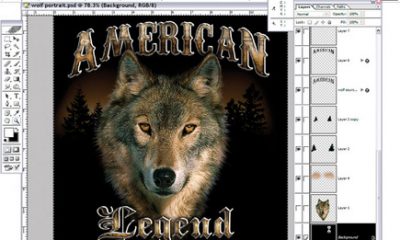Digital Printing
Published
10 years agoon

Sublimation is defined as the conversion of a solid to a gas without going through the liquid state. The solid in the case of decorative graphics is sublimation ink that has been printed and dried onto a specially coated transfer paper. Applying the graphic to a substrate by using a heat press at a temperature between 400-425°F causes ink to shift from a solid to a gas and transfer onto any polyester surface.
Sublimation is defined as the conversion of a solid to a gas without going through the liquid state. The solid in the case of decorative graphics is sublimation ink that has been printed and dried onto a specially coated transfer paper. Applying the graphic to a substrate by using a heat press at a temperature between 400-425°F causes ink to shift from a solid to a gas and transfer onto any polyester surface.
The quality of the transferred image depends on several variables: the type of printer used, artwork, ink, paper, heat press, and the substrate. It sounds a little daunting, but sublimation printing really is easier than it sounds—especially now that our industry has matured and many companies teach end users how to be successful with sublimation inks on a wide variety of substrates! A great place for beginners to learn about the process is to go online and start researching companies that sell sublimation inks and supplies and, of course, by watching some YouTube videos on the subject before buying a system. Industry trade shows are another great place to learn about sublimation.
My first encounter with a sublimation transfer was in the early 1980s. I was so impressed by the vivid colors and the soft hand that my first reaction was that sublimation printing would replace screen printing altogether! Of course, that never happened, because there wasn’t a good method to print sublimation inks in house at that time, polyester substrates were limited and expensive, and sourcing the inks was difficult. But by the late 1990s, all of these issues started to rapidly change with the discovery that sublimation inks could be printed digitally via the computer and inkjet printer. With the printing side of the equation solved, the next hurdle was finding consumables for sublimation. Soon, multiple manufactures started producing polyester-coated blank goods: mugs, mouse pads, key chains, and a wide variety of textile products.
Starting at the top
Sublimation artists work in the RGB color environment during the design phase. A good way to think of RGB color is that what you see on the computer screen is what your image will look on the substrate—or at least the way it should look on the substrate. To ensure the color that you see on your computer screen is reproduced accurately, it’s important to have the correct print driver installed for the brand of ink that you’re using. This part is easy, too—just ask your ink supplier for the recommended print driver for the type of ink they sell.
Print a primary color chart onto transfer paper and heat-apply this chart to white polyester fabric after the print driver is installed. You can use this color chart to show customers the actual primary colors that your system can reproduce and to act as a comparison guide at a later date when you check the inkjet nozzles for proper ink flow. It’s important to perform periodic nozzle checks to ensure proper ink flow through the printhead.
Another advancement over the past ten years is in the area of digital clip-art solutions for sublimation decorators. It’s no longer a requirement to be an artist, what with all of the digital artwork that is available today—everything from team mascots to civic groups. A couple of companies to consider for sublimation artwork are Great Dane Graphics (greatdanegraphics.com) and Unisub (unisub.com).
Lastly, it’s important to color-correct the image before you print the transfer; you can make manual color adjustments on your computer screen once you have gained the experience and have a feel for which colors need to be boosted and how to improve the contrast in a design. Most software has automatic color-correction adjustments, but the pros have their manual tricks that really help make a design pop off of the substrate.
The sublimation printer
Many types of inkjet printers are available for sublimation printing: Epson, Mimaki, Roland, Ricoh, and others. Many beginners start out with an inexpensive Epson desktop model and, as they develop their printing skills, move up to wider print formats. If you decide to start out with an inexpensive model, you can expect the printer to only last a year or two (maybe less), because these inkjet printers are made for the home user and not for high-volume printing.
Large-format, professional-grade inkjet printers are built for businesses that are printing in high volumes and have the need for high production speeds. These printers are also more economical in regards to ink costs and have the option of adding bulk-ink-delivery systems that will also greatly reduce the print cost of the transfer.
Piezo inkjet printheads are ideal for sublimation printing because they use vibrating crystals (instead of heat) to deliver ink droplets onto the substrate in a uniform and controllable fashion. It is important to keep the printer in a room that is humidity controlled. If you live in a very dry region of the country, a humidifier should also be purchased to keep the room humidly level between 40-60% to reduce the chance of the inks drying in the printheads.
Do not let your sublimation inkjet printer sit idle for long periods of time without printing. Doing so runs the risk of having clogged printhead nozzles. If your print demand is low, it is a good idea to print a nozzle check periodically to keep the ink flowing through the printheads. When sublimation inks sit idle in the print nozzles for long periods of time, the moisture dries out of the ink, leaving behind a crust of pigment that will clog the printhead.
Direct dye-sub printing
Direct-to-fabric printers, used primarily in the fashion industry, eliminate the need for carriers and heat transfers. Direct-printed fabric is fed through a heated calender that heats the print evenly and causes the ink to sublimate into the synthetic fabric. These units typically have an on-board calendering heating system that consists of two heated rollers that press the fabric as it passes through. Because these direct-to-fabric printers are capable of imaging an entire bolt of fabric, a bulk ink system is a must to keep feeding the ink to the fabric during an eight-hour production shift.
Sublimation inks
Sublimation inks have been around for decades, but growing accessibility to inkjet printers over the past 15 years has dramatically increased the market share. The vast majority of sublimation ink is water-based and is ideal for printing with piezo inkjet printers. Oil-based sublimation inks are available for offset and large-format sublimation printing.
The most commonly used brands of sublimation ink in our industry are ArTanium UV and Sublijet IQ from Sawgrass Systems and, for large-format dye-sublimation printing, Manoukian inks distributed by TW Graphics. Nazdar carries a line of Lyson inks for large-format printers made to be used in Epson, Roland, Mimaki, and Mutoh inkjets. Sublimation inks can be purchased in cartridges or in bulk supply.
Sublimation inks are translucent in nature and should only be printed on white or pastel backgrounds for best results. Remember that there is no white sublimation ink available, so the graphic designer must let the white color of the substrate show through in the design if the image requires white as part of the composition. Letting the white fabric show through is a technique widely used in soccer uniforms in Europe. The bright, white numbers on the colorful European soccer uniforms is the white fabric showing through the sublimated graphic. This is a great design technique.
Sublimation paper
Carrier stock is critical in transfer-sublimation printing. It’s typically available as a coated inkjet paper that’s designed to hold the right amount of ink on its surface without wicking ink into the grain of the paper. If the sublimation ink is wicked into and trapped in the paper, not enough color will transfer to the substrate.
If you’re getting low-quality transfers, don’t be too quick to blame your inks or your heat press. Instead, try some different sublimation paper. It’s important to store sublimation paper in a sealable container to keep moisture out.
The heat press
The heat press is one of the most important pieces of equipment in the transfer-sublimation process. The image-transfer process is dependent on three variables; time, temperature, and pressure, so it’s important to purchase a machine that accurately controls all three. Heat presses come in two basic configurations: clamshell and swingaway models. The clamshell press, as the name implies, opens up at a 45° angle, and the swingaway model features a heat element that swings away from the lower platen.
Many sublimation decorators prefer the swingaway model, where the heating element comes down parallel to the lower platen and reduces the chance of the paper shifting when the element is brought in contact with the transfer and substrate. Another reason for the popularity of the swingaway press is the fact that 3D items like wood plaques and ceramic tiles can easily be imaged on this type of system.
The most standard heat-platen sizes in the garment-decorating industry are 15 x 15 in. and 16 x 20 in.; however, the popularity of all-over sublimation printing is on the rise, so jumbo heat presses in formats such as 30 x 40 in. are gaining in popularity. The oversized heat presses are also ideal for sublimating ceramic tile murals all in one step! Sublimation is an excellent way to add a new revenue stream to any printing operation. Do your homework on the subject, go to a trade show and talk to the experts, and get started in this exciting decorating process!
James Ortolani manages ink R&D for Stahls’.

Subscribe

Magazine
Get the most important news
and business ideas from Screenprinting Magazine.
Most Popular
-

 Art, Ad, or Alchemy1 month ago
Art, Ad, or Alchemy1 month agoF&I Printing Is Everywhere!
-

 Case Studies1 month ago
Case Studies1 month agoHigh-Density Inks Help Specialty Printing Take Center Stage
-

 Andy MacDougall1 month ago
Andy MacDougall1 month agoFunctional and Industrial Printing is EVERYWHERE!
-

 Columns2 weeks ago
Columns2 weeks ago8 Marketing Mistakes Not to Make When Promoting Your Screen Printing Services Online
-

 Editor's Note2 weeks ago
Editor's Note2 weeks agoLivin’ the High Life
-

 Marshall Atkinson2 weeks ago
Marshall Atkinson2 weeks agoHow to Create a Winning Culture in Your Screen-Printing Business
-

 Thomas Trimingham2 months ago
Thomas Trimingham2 months ago“Magic” Marketing for Screen Printing Shops
-

 News & Trends1 month ago
News & Trends1 month agoWhat Are ZALPHAS and How Can You Serve Them in Your Print Business?






